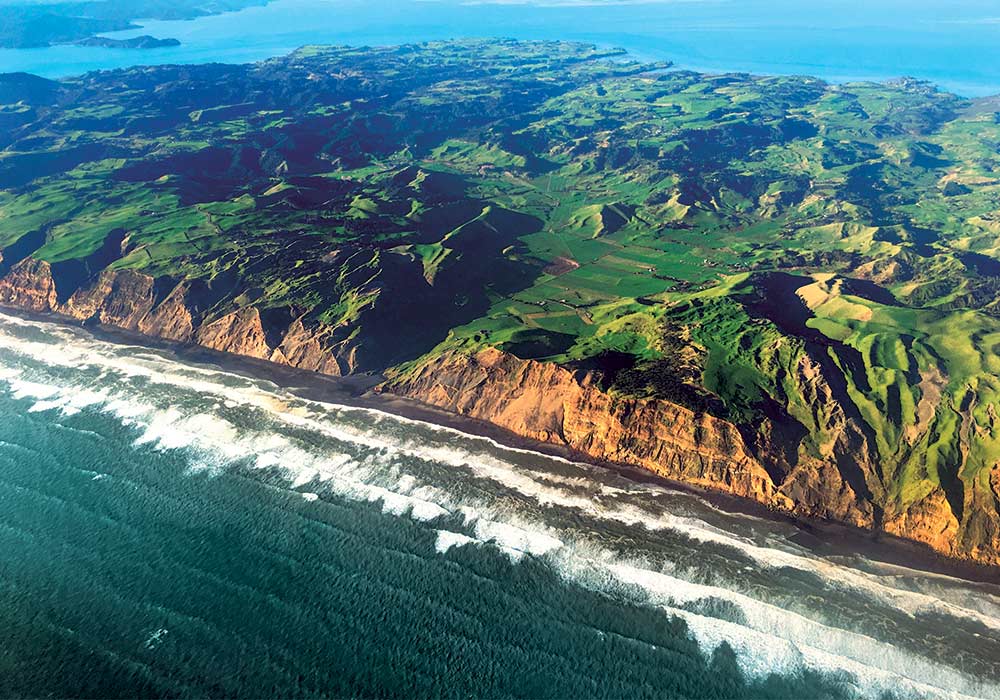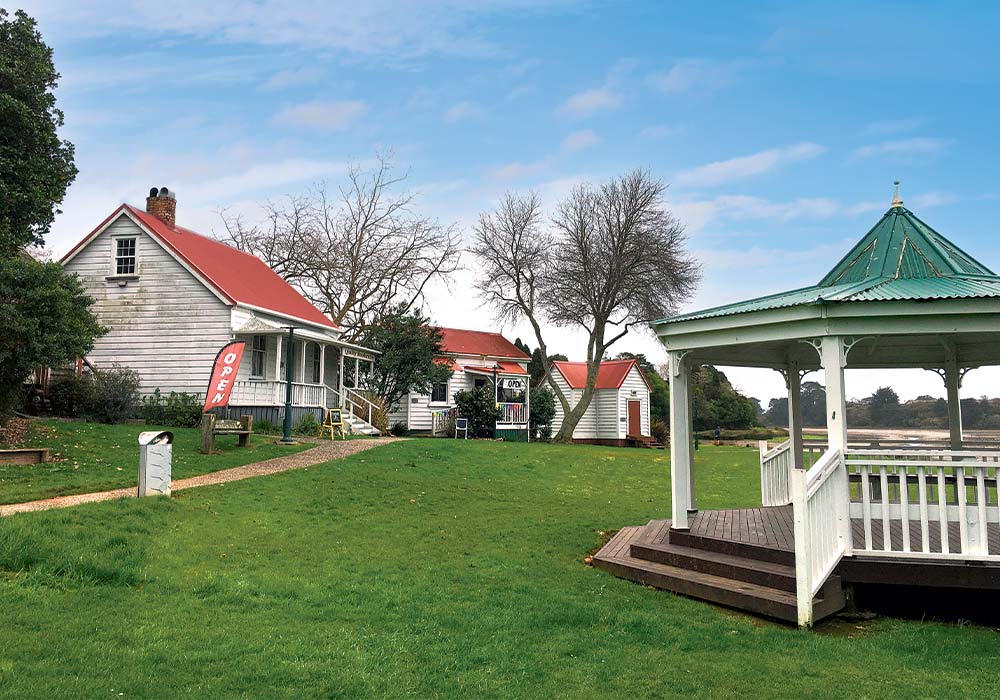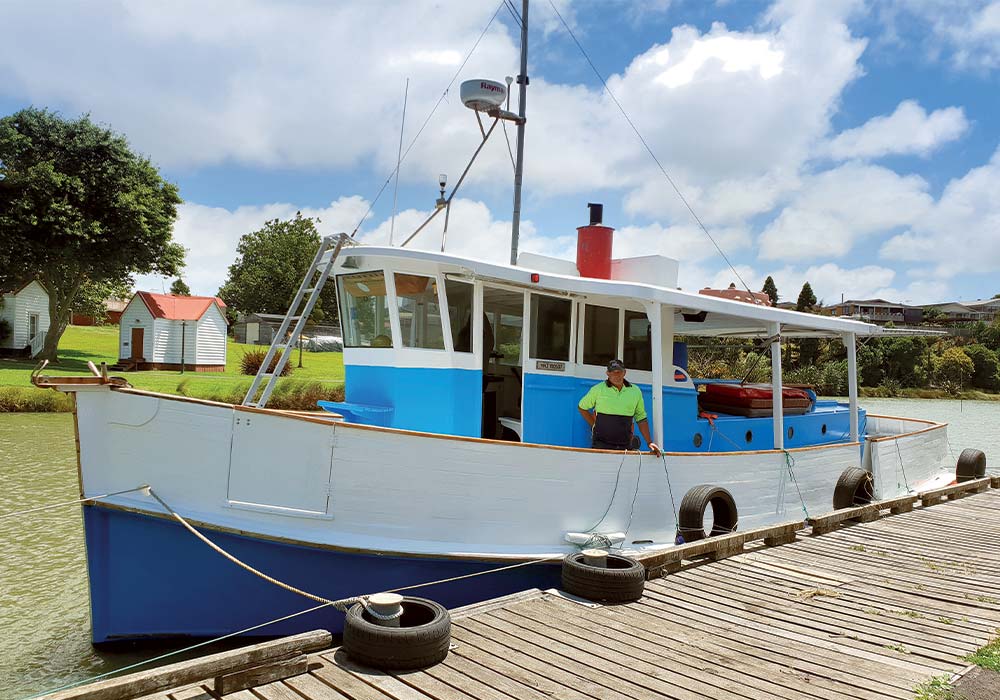Waiuku is the perfect example of always looking beyond the name. While Waiuku may mean ‘muddy waters’, that’s definitely no reason to pass it by, says Pamela Wade.
Not that you would anyway: tucked in at the base of the Āwhitu Peninsula on the far side of the Manukau Harbour, it takes a deliberate decision to visit this little town of fewer than 10,000 souls, and it’s one you should make, for many reasons.
Spectacular scenery

There’s the surrounding scenery, for a start. You’ve probably flown over this stretch of coast and thought, “That’s one long and very straight beach down there. Impressive.” At sea level, it’s even more spectacular.
Tall, sheer, and picturesquely weather-sculpted sand cliffs tower over the black iron sands of Karioitahi Beach, while serious waves roll in from the Tasman. Although you’re only a short, but strikingly picturesque drive from Waiuku, it feels remote and untouched – until, that is, you notice the scattering of dog-walkers, horse-riders, blow-carters, paragliders, and even surfers who are also glorying in this raw and dramatic setting. If you have a beach driving permit, you can head in either direction, perhaps to be tempted into a cliff scramble for even more extensive views.
Perched on the clifftop above is the five-star Castaways Resort, with magnificent views from its restaurant and bar and the perfect spot to watch a sunset.
Further up the peninsula is Hamilton’s Gap, the location of Auckland’s highest sand dunes. It’s tempting to haul a boogie board up the dunes for at least one exciting slither back down, but even a gentle walk along the stream out to the headland is visually rewarding.

Right at the northern tip of the peninsula, the 1874 Manukau Heads Lighthouse would deliver stunning views, but it’s sadly still closed after Cyclone Gabrielle damage. Next-door Wattle Bay offers a taste of that scenery, and Big Bay Holiday Park is nearby beside a lovely curve of sheltered beach. There’s a range of attractions on this inland side of the peninsula, including more beaches, golf, a winery, and several easy walks in the Āwhitu Regional Park.
It’s worth seeking out the Pollock Arts Co-op for its local art, sculpture, and crafts.
At the southern end of the peninsula, overlooking the mouth of the Waikato River, is Waiuku Forest, where you’ll find a network of unsealed roads and dog-friendly walking tracks along beaches and through bush and farmland, plus the unexpected glimpse of a major industrial unit. The works here mine the iron sand, or titanomagnetite, pumping it underground 18km to Glenbrook where, in a world-first process, it’s turned into steel. The steaming chimneys are used by locals as weathervanes, and the mill itself is the area’s lifeblood. For something more soothingly natural, call into Leafy Hollow Lavender on your way back into town, where many different species are grown and made into a range of sweetly scented products.
Rich heritage and charm

Waiuku itself is charmingly historic and pretty. Located on the original main route from Waikato to Manukau, it was first used as a port by Māori who had to drag their waka for more than a kilometre overland between the Awaroa River and the harbour, and then from 1843 by Europeans transporting goods from the Waikato farmlands. It became a trading post where weary travellers could take a break – and so the Kentish Hotel came into being. Built in 1851, it claims to hold the country’s longest unbroken liquor licence. Worth a visit for that alone, it’s not only a very photogenic building inside and out, with historical images on its walls, but also warmly welcoming and serving excellent refreshments.
It’s only a short walk from the hotel to where the river enters the estuary. Tamakae Reserve runs along one bank, scattered with well-maintained heritage buildings. At its entrance is a striking swamp kauri carving of Tamakae, the successful suitor who, once he’d washed off the mud from digging kumara (hence the town’s name), beat his brother Tamakau in winning the heart and hand of the local chieftainess. This story, and plenty more history, can be discovered in the museum in the old fire station, such as the country’s worst shipwreck, the Orpheus in 1863, when it ran aground on the Manukau Bar and 189 lives were lost. The town’s original jail is here, too.

It’s worth following the short heritage trail along Queen Street to see the delightful old buildings; on the other side of the estuary is a botanic reserve. Departing from the nearby old Waiuku Wharf are Manukau Charters, who offer fishing trips and Devonshire tea cruises on the vintage, kauri-built Ratahi. It’s a relaxing way to get an overview of the area’s scenery and history, with the possibility of spotting dolphins and seals along the way.
There’s more heritage transport to enjoy not far away, both large and small. The Glenbrook Vintage Railway offers a 70-minute chug on its steam train, as well as plenty of history around the site, and the Glenbrook Model Railway presents meticulously accurate small-scale trains, tracks, and scenery. After exploring all that, it’s no surprise to learn that Āwhitu means ‘longing to return’.
Where to stay
- Hamilton’s Gap has a free camping site with basic facilities
- Big Bay Holiday Park
- Peninsula Campground in Āwhitu Regional Park
- Sandspit Motor Camp in Waiuku






